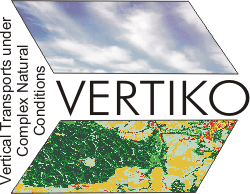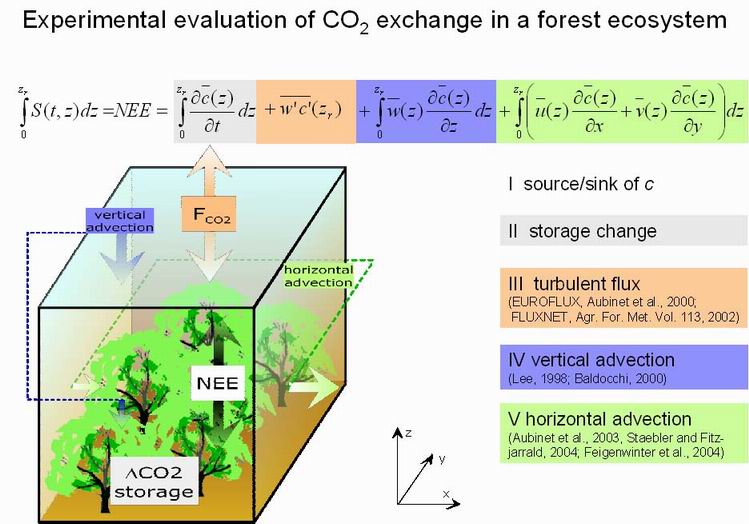 |
Vertical Transports of Energy and Trace
Gases at Anchor Stations and Their Spatial /Temporal Extrapolation under Complex
Natural Conditions (VERTICO)
In the frame of the "Atmospheric Research
Program 2000" (AFO2000)
by the German Bundesministerium für Bildung und Forschung (BMBF). |
Contact: Dr. R.
Vogt Dr.
C. Feigenwinter I.
Lehner
Overview
Effects
of advection on surface fluxes in complex terrain
In the recent past, long-term carbon flux
networks were established in Europe (EUROFLUX, CARBOEUROFLUX, i.e. Valentini et.
al., 1996; Valentini et al., 2000; see also http://www.bgc-jena.mpg.de/public/carboeur/)
and in the Americas (AMERIFLUX, see also http://public.ornl.gov/ameriflux/) to
enhance our knowledge of terrestrial carbon exchanges. In the late nineties
these efforts were embedded in the worldwide FLUXNET (Baldocchi et al., 2000;
Special issue FLUXNET 2000 synthesis, Agric. For. Meteorol., 113, 2002; see also
http://www.eosdis.ornl.gov/FLUXNET/). The flux networks mentioned above usually
ignore the advective terms of the conservation equation and determine Net
Ecosystem Exchange (NEE), by using the Eddy Covariance method (Moncrieff et al.,
1997; Aubinet et al., 2000), which relies on the measurement of the turbulent
vertical flux of CO2 above the canopy, and the carbon storage change in the
layer below the eddy flux sensors. (NEE also can be evaluated using biometric
methods.) Missing data due to instrument errors or conditions in which the eddy
covariance method is questionable (i.e. under stable nighttime conditions and
weak turbulence or heavy precipitation) are usually corrected by models based on
soil temperature, photosynthetically active radiation (PAR) and the so called u*
correction (Goulden et al., 1996; Grünwald and Bernhofer, 2000; Falge et al.,
2001a,b). However, the presence of a tall vegetation, topography, mesoscale
heterogeneity and ensuing mean vertical flow creates complications which were
recently addressed by Lee (1998), Bernhofer and Vogt (1999), Finnigan (1999),
Paw U et al. (2000), Finnigan et al. (2003) and Aubinet et al. (2003). All of
these studies consider the NEE advection terms at forested sites in complex
terrain (i.e. tall vegetation, non-flat terrain, heterogeneous canopy, etc.).
Especially during stable nighttime conditions, the CO2 fluxes measured by the EC
method are typically underestimated, which can result in an erroneous evaluation
of the annual carbon sequestration (Baldocchi et al., 1997; Aubinet et al.,
2000; Eugster and Siegrist, 2000; Lee and Hu, 2002). Beside the well known and
largely discussed measurement errors like high frequency flux loss caused by EC
instrumentation and closed path sensors (Leuning and Moncrieff, 1990; Bernhofer
et al., 2003), low frequency flux loss due to too short averaging intervals
(i.e. Massmann and Lee, 2002) and errors in storage measurements, there is
evidence that the neglected advective processes are responsible for the
underestimation of nighttime fluxes rather than measurement errors (Lee and Hu,
2002; Aubinet et al., 2003, Staebler and Fitzjarrald, 2004).
As a consequence, the experimental setup of future micrometeorological sites
should be designed to account for the entire mass balance in a
soil-vegetation-atmosphere volume. This holds especially for typical forest
sites with complex topography and limited fetch. It is also a very ambitious
challenge, since it requires more than one tower for measurements, which will
multiply the costs for the infrastructure and instrumentation. Therefore, the
optimum design has to be evaluated by short term measurement campaigns.
The central object of this research in the frame of the AFO 2000 project VERTIKO
is to experimentally evaluate the advective fluxes as a part of the
soil-vegetation-atmosphere exchange of trace gases (e.g. carbon dioxide). Two
advection experiments have been carried out, namely MORE I and MORE II (More
measurements in the ORE mountains). While the first experiment MORE I (Sep/Oct
2001) was a short term pilot study to check out the feasibility of CO2-advection
measurements, the second experiment MORE II (Mai/Oct 2003) covered nearly a
whole vegetation period with a highly improved experimental setup based on the
experiences of MORE I.

MORE I photo gallery
MORE I: Presentation at the 5th BIOMET
Confererence, 2003, Dresden (pps-file)
MORE II photo gallery
MORE II: Presentation at EGU
2004, Nice (pps-file)
Progress report
2001 (pdf-file)
Progress report
2002 (pdf-file)
Progress report
2003 (pdf-file)
References:
Feigenwinter C., Bernhofer C. and Vogt R. (2004): The
influence of advection on the short term CO2-budget in and above a forest
canopy, Boundary-Layer Meteorol., (in press)
Back to MCR
LAB

